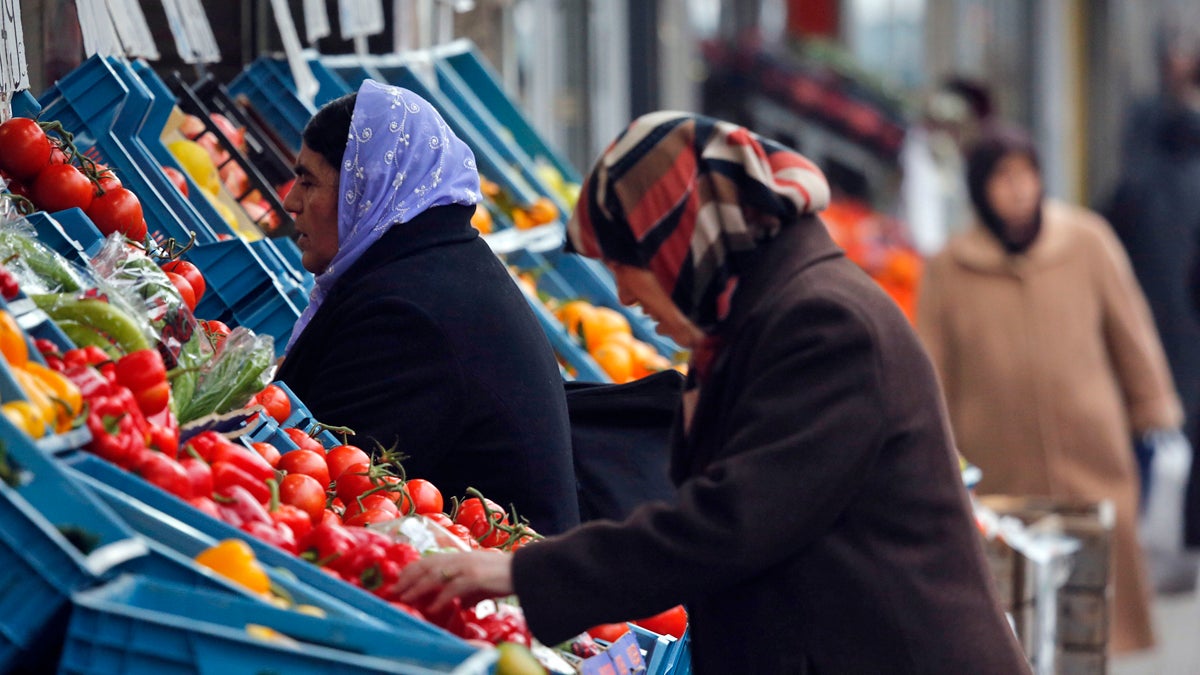How Berlin is helping immigrants and trying to get residents to think differently about national identity

Women wearing head scarves buy fruit in a street in Duisburg, Germany. ( AP Photo/Frank Augstein)
The third in a series of Keystone Crossroads posts from German cities.
I’m spending a few weeks in Germany as part of a German/American journalist exchange program through the RIAS Berlin Kommission and the Radio Television Digital News Foundation. During the trip, I’m sending back lessons on urban planning and revitalization from German cities. Today’s topic: how Berlin is helping immigrants integrate into the city.
Imagine showing up in a new country where you don’t speak the language and you don’t have a job. Maybe you fled your country because of a war or because there’s no economic opportunity. Maybe you’re just looking for a better life.
You need to comply with local immigration laws, but that might be hard, since you don’t understand the language and you’re not a lawyer. You need to find a place to live and a job. If you don’t speak the language, you might feel isolated and lonely. And on top of it, you’ll probably come into contact with people who don’t want you in their country.
This is reality for immigrants and refugees in cities around the world.
In Berlin, it’s no different. Twenty-eight percent of Berlin’s population is foreign-born, with residents from more than 180 countries. The city has a especially large number of Turks and Kurds.
Berlin has a lot in common with certain Pennsylvania cities. Nearly 18 percent of Reading’s population is foreign-born, mostly Latino, according to U.S. Census data from 2013. About 64 percent of that group indicated that they speak English “less than very well.”
In Allentown, 14.5 percent of the population is foreign-born, and nearly 65 percent of that group is Latino. Nearly 60 percent speak English “less than very well.”
And 12 percent of Philadelphia’s population was born outside the U.S., though there’s much more diversity in country of origin than in other Pennsylvania cities. About 51 percent of those immigrants said they don’t speak English very well.
All these cities are making efforts to incorporate these immigrants, and like Berlin, they have limited budgets and resources.
While I was in Berlin last week, I met Elke Pohl, the press officer for the Berlin Commissioner for Migration and Integration.
Pohl said the commissioner’s office helps immigrants with practical issues, like learning German and getting the papers they need. But it also attempts to change Germans’ minds about immigration and to get them thinking differently about their national identity.
Lessons from Berlin
Berlin does not have all the answers, but here are a few things it does:
It provides legal advice for immigrants. This can be a huge help, especially because people who just moved to Germany often don’t have jobs yet or a lot of money to burn.
It communicates with other city departments on behalf of immigrants. This cuts through some layers of bureaucracy, because it allows one municipal department to communicate with another, rather than requiring a non-native speaker to try to communicate with city hall. (That can be difficult for even native speakers, as many Pennsylvanians can attest). For example, Pohl’s office will speak directly with the social affairs department, which decides whether to grant refugee status or citizenship, on behalf of an immigrant.
It’s actively recruiting immigrants to city government. Currently only 2 to 3 percent of Berlin’s government workers are foreign-born. On a practical note, foreign-born city employees can help departments communicate with immigrants. But they also understand what it’s like to start a new life in a strange city. And empathy can go a long way in helping a city understand the immigrant experience.
It has launched campaigns to change the way people think about German identity. Picture what a German looks like. Are you imagining someone tall, maybe with blonde hair and blue eyes? That’s the stereotype, and it needs to change, said Pohl. The office has put up posters and ads saying that “the German passport has many faces,” along with photos of Germans who were born in other countries. “It’s important to show that it’s a normal thing to have a German passport and look however you want,” she said. That campaign also urges immigrants to apply for German citizenship.A little context: immigrants are particularly important to Germany, which has a much lower fertility rate than that of many European countries. That means the country’s tax base is decreasing, and eventually there won’t be enough money to support social services for Germany’s aging population. Some Germans hope immigrants will be able to fill that gap.
Bringing it home
Pennsylvania cities have made their own efforts to incorporate immigrants. In 2013, Philadelphia opened an Office of Immigrant and Multicultural Affairs, modeled after a similar department in New York City. Allentown also has an immigration office.
Pittsburgh just launched its own plan to make the city more welcoming to immigrants. The plan calls for a municipal ID program, more youth activities for immigrants and hiring more immigrants in city government, among other changes. Unlike Philadelphia, Reading and Allentown, Pittsburgh does’t have a large immigrant population — only 7.4 percent — but city officials want to draw more foreign-born residents, in part to boost Pittsburgh’s economy.
You can follow along with the trip through Germany at Keystone Crossroads, @PaCrossroads with the hashtag #kcgermany and on our Facebook page.
WHYY is your source for fact-based, in-depth journalism and information. As a nonprofit organization, we rely on financial support from readers like you. Please give today.


